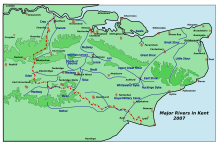Transport in Kent
Transportation needs within the county of Kent in South East England has been served by both historical and current transport systems.
Roads
The earliest footpaths and roads in Kent ran in a north-east/south-west direction. They followed the natural contours of the land and took advantage of the gaps in the
Water

The Cinque Ports were important mediaeval ports. They were Sandwich, Dover, Hythe, Romney and Hastings, and later Rye and Winchelsea. All of these have silted up, with the exception of Dover which is a busy RORO ferry port. Ramsgate is a container port. The Medway Estuary has been an important port and naval base for 500 years. The River Medway is tidal up to Allington and navigable up to Tonbridge. There are two canals in Kent, the Royal Military Canal between Hythe and Rye, which is still extant, and the Thames and Medway Canal between Strood and Gravesend. Built in 1824, it was bought up by the railways in 1846 and backfilled.[1]
The Port of Dover is the major port.
Railways

The earliest locomotive driven, passenger carrying railway in Britain was the
Kent also had a second major railway, the

The extensive competition saw the SER build a very expensive deviation via Orpington and Sevenoaks to avoid the lengthy and circuitous route via Redhill, opening in 1868. Thus towns such as Bromley, Gravesend, Strood, Rochester, Chatham, Sevenoaks, Maidstone, Canterbury, Whitstable, Ramsgate, Margate, Dover and Ashford 'enjoyed' having two stations.
The competition severely strained the resources of both companies, the LCDR given its later start, and the SER with neighbouring LBSCR to the west in Sussex and Surrey. Co-operation broke out with a
In the aftermath of World War I, with the SECR having borne extensive amounts of war traffic, the government "
Southern kept closed some inner London routes closed under wartime austerity measures, but embarked upon continuing SECR's rationalisation and a roll out of 660 V DC
World War II further devastated the railways, and post war the government nationalised the railways, forming

By the 1980s, the
"Javelins" were introduced in 2009.The late 1980s saw the organization of the railways change again, first with the "sectorisation" of

In addition to the "mainline" railways there are several light, heritage and industrial railways in Kent. There are three heritage, standard gauge railways;
Air

Kent was the forefront of the development of aviation in the UK with the
Military Aviation was widespread throughout the county, with the embryonic
With the approach of

Manston Airport was used as a commercial airport from 1989 until its closure in 2014. It is set to reopen in 2025 or 2026, with cargo and short haul flights taking off from it by 2028 or 2029.
Currently Biggin Hill and
Light aviation continues in Kent at the grass airfields of Rochester and Headcorn and at the two tarmaced airfields. The continued urbanisation of Kent and planning constraints have in recent times threatened Rochester airport with development, while continued aviation activities still encounter opposition on the grounds of noise pollution.
Bus
Up until the
After deregulation these were gradually taken over by large transport groups and today operators include
Commuter services are operated by Chalkwell Coaches, The Kings Ferry and Redwing Coaches into Central London.[3][4][5]
See also
References
- ^ a b Jessup, Frank W. (1966). Kent History Illustrated. Kent County Council.
- ^ Keegan, John (1989). Times Atlas of the Second World War.
- ^ Chalkwell says London coach commute is competitive Transport News Brief 6 January 2014
- ^ New Kings Ferry service Bus & Coach Buyer 26 August 2015
- ^ Gravesend to London Commuter Service Redwing Coaches
